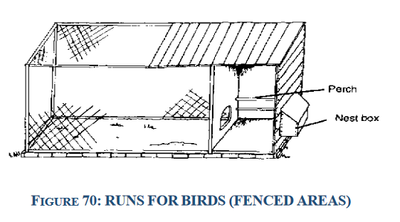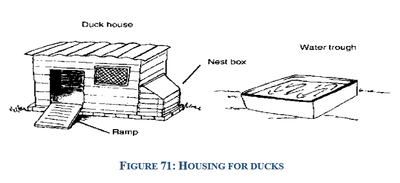Housing for Chickens and Ducks
Housing for Chickens and Ducks
Introduction
If birds are allowed to wander around freely, disease can spread quickly through all the birds kept in the community. Keeping birds in a closed area and providing them with shelter is the first step towards improving them. A covered shelter (house) will give chickens and ducks protection from wind, rain, snow and predators such as foxes.
Why we house chickens and ducks
If chickens and ducks are kept in houses:
- They will be protected from the sun, rain, cold and snow.
- They will be protected from other animals such as foxes and birds of prey, from theft and from being killed on the streets.
- Young birds are protected.
- Food and water can be controlled.
- Birds can be prevented from eating bad food or drinking dirty water.
- Nest boxes can be provided to make it easy to collect eggs.
- The spread of disease can be stopped.
How many birds should be kept in a house
There must be enough space to hold all the birds plus the feed and water containers (troughs). If too many birds are kept together they will start to peck (bite) each other. If any bleed, the problem will become worse, as more birds start to peck. Young birds will need less space than older birds and perches must be provided for chickens to roost on at night.
The ground or floor area required is:
- 50 chickens can be kept in 16 square metres (4m × 4m).
- 1 metre of perch must be provided for every 5 adult chickens.
Housing for chickens
Suitable housing for chickens should be:
- Built on high ground close to the home of the owner so that he can keep an eye on it.
- The house should be 2 metres high and it is better if the first 50 cm of the walls are brick, stone or concrete while the rest is wood, wood and mesh wire, corrugated iron sheeting or any other suitable materials. Small houses can be made from wood and mesh wire.
Runs for Birds (Fenced areas)
Every house will need a run for the birds to be able to exercise in, pick up grass, insects etc. The run must be fenced around with wire or other suitable material and if possible should be shaded by some trees. Part can be covered to allow birds to use it on rainy days. If possible the run should be divided into two areas to keep birds out of one area to allow fresh grass to grow 50 chickens require a 16 square metre house and 500 square metres of run.

Nesting boxes (for laying eggs)
Nesting boxes are boxes in which the hen can lay her eggs. You can make them from wood, baskets or pottery. Line them with straw or hay as a nest. Wooden boxes can be built on to the side of the house and opened from the outside to remove the eggs.
Housing for ducks
Housing for chickens can be used for ducks. However if you keep ducks you should remember:
- Ducks do not require perches and nesting boxes will need to be low to allow ducks to use them, or sloping ramps must be placed to allow ducks to get to the boxes.
- You will need to provide ducks with a container of water at least big enough for them to put their heads and necks into the water.

Laying ducks must be kept in the house each morning until they lay their eggs.
Source : Pashu sakhi Handbook
Last Modified : 7/3/2023
This topic provides information about Causes, targ...
This topic provides information about Sim Card Swa...
This topic provides information about 20th Livesto...
The Article provides information about Antioxidant...
